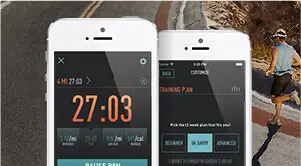If you have only eight weeks to train for your goal half marathon, complete fartlek workouts the first two weeks using the recommendations above, and on week three, move on to threshold runs.
When you're ready to progress to threshold runs (week three for those following an eight-week program, and week five for those following a 12-week program) complete 3 to 5 miles at a pace that is hard, but controlled. I cap the threshold workouts at 5 miles for my runners, and I'd recommend you do the same.
You know you're running at threshold pace when you're slightly uncomfortable, yet you don't have sensations like burning lungs or a nasty metallic taste in your mouth. If you're running with other people, you'll enter a realm where you can't complete sentences, but can only talk in short, staccato phrases. These are signs that you are dipping into anaerobic metabolism—the metabolism that produces lactate.
More: What Pace Should Runners Complete Lactate-Threshold Workouts?
Lactate is not a bad thing, but producing lactate is not the point of this workout. Complete threshold runs for two to four weeks, depending on which program you're following (two weeks for those on the eight-week program, and four weeks for those on the 12-week program).
The final speed workout is a progression run, which includes running at half marathon goal pace and speeding up after that. This is not only a great way to groove at the pace you'll be racing, but also an excellent way to get a hard stimulus. Progression runs teach you that you can continue to run strong even when you're uncomfortable. This is one of the keys to training: learning to maintain a given pace when you're uncomfortable. The best runners in the world are masters at this.
More: Running and Pain: How to Overcome Your Mental Blocks
Beginning runners can run 3 miles at half marathon pace, 2 miles faster, then 1 mile fast but controlled. Advanced runners can run 6 miles at half-marathon pace, 2 miles just a touch faster, then 1 mile hard but controlled.
You'll complete three weeks of progression runs during your training cycle. To make the progression runs more challenging, simply run the same mileage (as suggested in the previous paragraph) a little faster during week two. During week three, you can add a mile to the half marathon pace portion of the run if you'd like.
Eight-week Tuesday speed workouts outline:
Week 1: FartlekWeek 2: Fartlek
Week 3: Threshold
Week 4: Threshold
Week 5: Progression
Week 6: Progression
Week 7: Progression
Week 8: RACE
Twelve-week Tuesday speed workouts outline:
Weeks 1 to 4: FartlekWeeks 5 to 8: Threshold
Weeks 9 to 11: Progression
Week 12: RACE
Remember: Don't forget the long run. Find a coach who can help you with a good long run progression if you're new to the half marathon distance. You don't need to have run 13.1 miles before the race to have a good experience, but you should have run at least 10 miles before race day—11 or 12 miles would be preferable. For advanced runners, getting in as many runs over 13.1 miles as you can will only help you run a personal best.
More: How to Train to Run Your Half Marathon PR
Connect with us on Twitter, Facebook, Instagram or Pinterest for more tips, recipes and ideas to fuel your ACTIVE life.
 Sign up for a half marathon.
Sign up for a half marathon.
- 4
- of
- 4
About the Author

Get ACTIVE on the Go


13.one Half Marathon
Get expert advice and guidance as you progress in your journey to becoming an avid runner.
Available for iOS







Discuss This Article